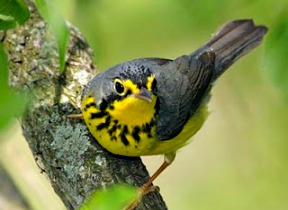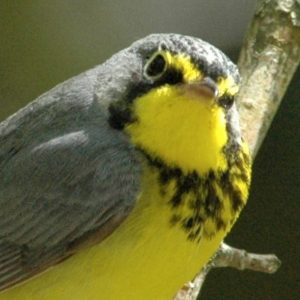Species Spotlight: Canada Warbler
[separator headline=”h3″ title=”Why the fuss about this bird?”]

Canada Warbler
Scientific Name: Cardellina canadensis
Other/Previous Names: Wilsonia canadensis
SARA status: Threatened (2008); Ontario: Special Concern; New Brunswick: At Risk
Taxonomic Group: Birds
Size: wingspan 12-15 cm
Canada Warbler males, which have a bluish-grey tail and upper parts contrasting with a yellow throat and breast, are typically more brightly coloured than the females and immatures. In both sexes, black stripes form a collar on the breast, although this collar is less defined on the females. In the males, the head is bluish with a black forehead and cheeks, which join with a band of well-defined black stripes that run across the breast. The forehead and cheeks of the female are bluish-grey rather than black. The bill is thin and there are yellow “spectacles” round the eyes. The adult plumages are similar throughout the year.
The Canada Warbler build the nest on or very close to the ground, often in dense ferns or fallen logs. The female lays four to five eggs once a year, and incubation lasts about 12 days. The chicks remain in the nest for about 10 days after hatching, and they are dependent on their parents for two to three weeks after they leave the nest. Although the Canada Warbler is territorial during the breeding season, it can occur in small groups with mixed-species flocks during dispersal and migration and on wintering sites.
The Canada Warbler feeds mainly on flying insects, such as mosquitoes and butterflies and moths, and spiders in the shrub layer.
Between 1968-2007, the Canada Warbler populations have declined by an average of 4.5% per year. Habitat loss and degradation to agriculture, and commercial or residential development at the breeding and wintering grounds are held responsible for the decline in this species.
Where can you see the species?
Eighty-five percent of all Canada Warblers breed in Canada, where their range extends from the southeastern tip of Yukon to the Maritimes—the highest population densities are in New Brunswick, Ontario, and Québec. Across Canada, the Canada Warblers are found in many forest types, from conifer swamps to riparian woodlands; they are most common in cool, damp, mixed deciduous-coniferous forests with well-developed shrub layer. Because of their preference for dense habitats, these brightly-coloured songbirds are more frequently heard than seen. In the spring, males can be heard singing a distinctive song of clear, liquid notes ending emphatically.
Did You Know?
Not only do Canada Warblers require a well-developed shrub layer for their nesting sites, they also prefer this habitat at stopover sites as they make their way to their wintering grounds in South America’s Andean forests. Wintering grounds too whether they are in forests, coffee plantations or hedgerows must have dense undergrowth.
Despite their name, Canada Warblers spend more time on their wintering grounds in the Andean forests than in Canada. They are the last of the warblers to arrive on their breeding grounds in late May to June and they are the first to leave in mid-July to mid-September.
What can you do to help the Canada Warbler?
Be respectful and observe from a distance: As with all wildlife, don’t disturb or harass the birds or nesting sites.
Prevent window collisions: Birds will fly into windows because they see nature reflected in the glass. Make your home or cottage windows visible to birds by applying UV reflective window decals, or strips or blocks of tape, or hanging exterior netting in front of particularly deadly windows. In the spring and fall, turn off exterior lights and draw curtains at night to prevent migratory birds from colliding with windows.
Purchase shade-grown coffee and organic chocolate products: Coffee and cacao trees grown in the shade of larger tropical forests provide valuable habitat for migratory birds and other wildlife. The combination of foliage cover ensures that there is greater biodiversity in species, protects the crops from pests and invasive species, and reduces the need for pesticides and herbicides.
Protect any forests and surrounding natural vegetation in private and public spaces: As with many other rare plants and animals, the Canada Warbler is at risk due to the loss of forested areas. Work with your community to restore bird habitat.
Support the protection and recovery of species at risk and their habitats: Private land owners have a very important role to play in species recovery. You may be eligible for stewardship programs.
Support groups that protect birds: Bird Studies Canada is working to advance the understanding, appreciation and conservation of wild birds and their habitat in Ontario and elsewhere. For more information visit: www.bsc-eoc.org.


